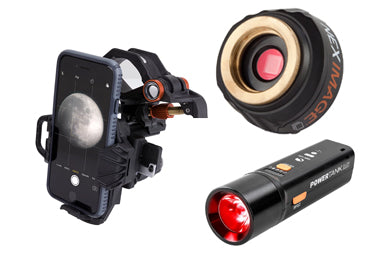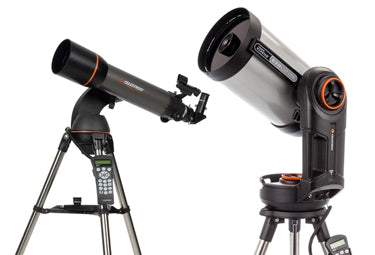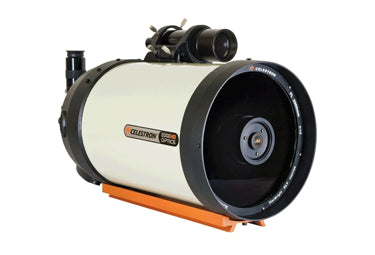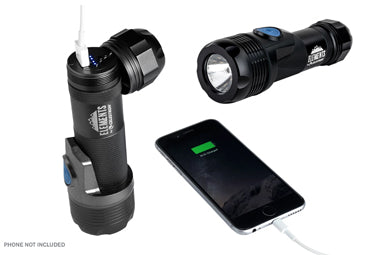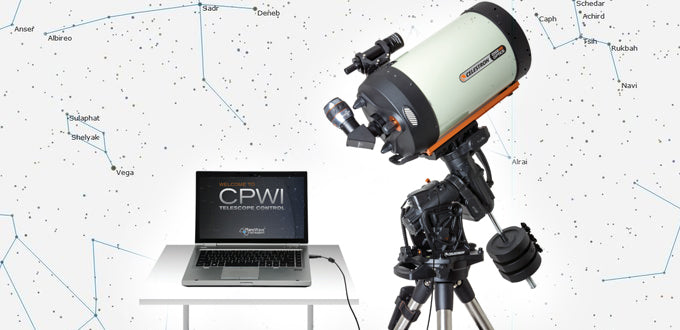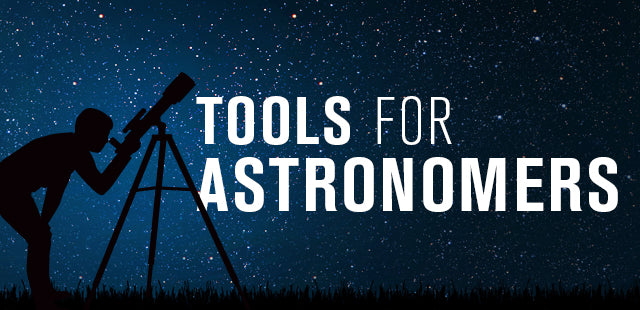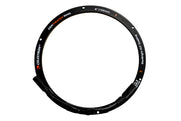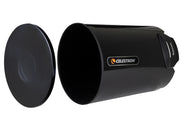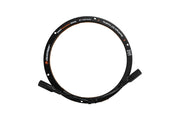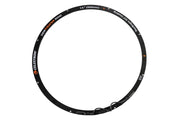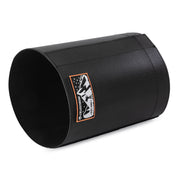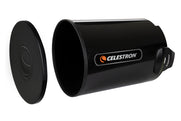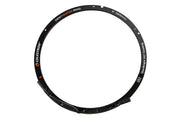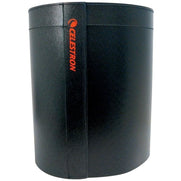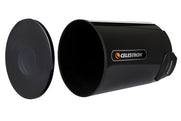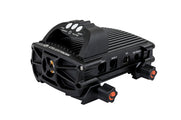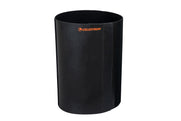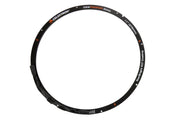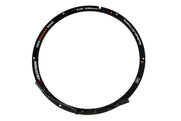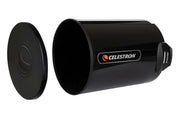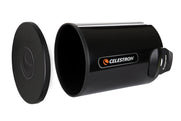The Ultimate Guide to Observing the Winter Sky (Northern Hemisphere)
March 2, 2021

Wintertime in the Northern Hemisphere – that magical season when nights stretch long, and the landscapes are wrapped in blankets of snow. The sky is a spectacle on these cold, crystal-clear winter nights. Fainter stars twinkle in abundance, while the brightest stars in the most famous constellations light up the night sky.
Winter is also a favorite time for many budding stargazers and their families to test the new telescopes they received from under the Christmas tree.
Whether you're just starting or have some stargazing experience, this guide will help you get to know some popular winter constellations. We'll also point out the coolest celestial targets within these constellations. So, bundle up, put on your gloves and beanies, warm up some hot chocolate, grab your new telescope or binoculars, and head outside to explore the winter sky!
Popular Wintertime Constellations and Asterisms
In ancient times, our ancestors gazed at the heavens and noticed new star groupings appearing each season. This predictable cycle of constellations repeats year after year. Using their vivid imaginations, they saw these groupings as patterns resembling mythological characters, animals, and objects, which they named accordingly. Many constellations and star names have Greek, Latin, or Roman origins, so you might already recognize some. One thing is certain: identifying the most popular constellations will make your stargazing sessions much more enjoyable. There are nearly twenty winter constellations, but here are some of the most prominent ones:
 |
Orion Orion, the Hunter in Greek mythology, is one of the most recognizable and easiest-to-identify constellations in the Northern Hemisphere's winter sky. In the Southern Hemisphere, it is visible in the summer sky and is seen upside down! If you use your imagination, Orion appears like a "bow-tie" in the sky! Three medium bright bluish stars in a row, Alnitak, Alnilam, and Mintaka, comprise Orion's Belt. The four corner stars, the reddish star Betelgeuse top left, Bellatrix top right, Saiph bottom left, and bluish-white Rigel bottom right, make out Orion's body. Some fainter stars create patterns that make Orion appear holding a club and shield as he faces a charging Taurus. You might notice three faint stars that make up his sword region, including a "fuzzy star" in the middle. We will cover that later. |
 |
Taurus Taurus, the Bull, can be seen to the upper right of Orion. This easily recognizable zodiac constellation is famous for its V-shaped horns and appears to be charging at Orion. Taurus is easy to find and can be seen from the city. Its bright reddish-orange star, Aldebaran, forms one of the bull's eyes and helps find the famous Hyades star cluster. Although Aldebaran appears to be part of the cluster, it is not, and it is further away but lies in the same line of sight. |
 |
Auriga The celestial Charioteer Auriga is shaped like a pentagon and can be found above the constellation Taurus. Both Taurus and Auriga share the same star, El-Nath. Auriga can be identified by its brightest star, Capella, a multiple-star system consisting of four stars — two large binary stars and two fainter binary dwarf stars. Auriga is often shown holding a female goat and three baby goats, known as "The Kids," along with the reins of a chariot. Several bright open clusters are visible because part of the winter Milky Way passes through its borders. |
 |
Gemini Gemini, the Twins in Latin, is another zodiac constellation located to the upper left of Orion and between fellow zodiac constellations Taurus and Cancer. The two brightest stars in the constellation are named after Pollux and Castor, two bright stars in Greek mythology. They represent the heads of the twins. Fainter stars outline their bodies down to their feet. Pollux, a golden star, is known to have an extrasolar planet or exoplanet. Scientists estimate it has a mass of at least 2.3 times that of Jupiter! Castor is white with a tinge of blue, but what makes Castor unique is that it is a triple star. Each of its components is a double star, so there are six stars in all! |
 |
Canis Major Canis Major, the Big Dog, and Orion's faithful companion, stands below and to the left of his master, who dominates the winter sky. The three bright stars in Orion's belt point to the brightest star in the night sky, Sirius, also known as the Dog star, which makes up the canine's head. Sirius appears to be a single star but is, in fact, a double star. Its faint companion star, Sirius B, "The Pup," is a white dwarf that orbits the primary star every 50 years, making it a binary star system. Sirius is near Earth, only 8.6 lightyears away from us. |
 |
Canis Minor Unlike its bigger brother, Canis Major, Canis Minor, the Little Dog, is the smaller of Orion's two hunting dogs between Canis Major and Gemini. Its constellation is only composed of two naked-eye stars resembling a straight line. Procyon is the brighter star of the two, known as the "Little Dog Star." This white/yellow star can be located by drawing an imaginary line through the two stars marking Orion's shoulders, Betelgeuse and Bellatrix. And just like Sirius, Procyon is a binary star system with a white dwarf star and is a close neighbor at 11.5 lightyears from us. |
 |
Lepus Lepus, "the Hare" in Latin, lies south of the celestial equator but can be seen in the Northern Hemisphere in winter. It is a small constellation found just below Orion. First identified by the Greek astronomer Ptolemy, Lepus is represented as a rabbit pursued by Orion and his two faithful hunting dogs, Canis Major and Canis Minor. Luckily for the rabbit, Orion encountered Taurus the Bull instead, but the rabbit's "on the run" position is forever etched in the sky. |
 |
Winter Hexagon One of two major asterisms seen in the winter night sky, the Winter Hexagon is not an official constellation but an outline formed by seven first magnitude or brighter stars in six prominent winter constellations: Sirius in Canis Major, Procyon in Canis Minor, Pollux in Gemini, Castor in Gemini, Capella in Auriga, Aldebaran in Taurus, and Rigel in Orion. Use your imagination and connect with the stars to see this cool wintertime pattern. No binoculars or telescopes are needed. |
 |
Winter Triangle The second of two major asterisms seen in the winter night sky, the Winter Triangle, is not an official constellation. Its outline is formed by three zero magnitude or brighter stars in three prominent winter constellations: Betelgeuse in Orion, Procyon in Canis Minor, and Sirius in Canis Major. Use your imagination and connect the stars to see this cool wintertime triangle of bright stars. No binoculars or telescopes are needed. |
Top Wintertime Celestial Objects
Now that we have identified the brighter, well-known wintertime constellations, let us look at the most observable celestial objects in most entry and mid-level telescopes from a modest 60mm on up. Although there are not as many impressive galaxies to view this time of year, there are many star clusters and famous nebulae. Springtime is galaxy season, which we will cover in our springtime viewing guide.
 |
The Orion Nebula (Messier 42) The Orion Nebula, also known as M42, is one of the most famous and easily visible deep sky objects in the winter sky. M42 is located in Orion's sword region and, with the unaided eye, appears to be a "fuzzy star" shining at magnitude 4. The nebula is transformed into a huge grayish "cosmic flower" of gas and dust through a telescope or a small pair of binoculars. M42 is an interstellar nursery where baby stars are formed. The famous cluster of stars called the Trapezium is in the nebula's core. It illuminates the gases in the Orion Nebula, a diffuse cloud of gas and dust about 1,300 lightyears away. Its beautiful colors of red and purple reveal themselves in short and long-exposure imaging. |
 |
Pleiades Star Cluster (Messier 45) The Pleiades, also known as "The Seven Sisters" or M45, is an easily visible wintertime object in Taurus that resembles a "little dipper" with a trail of stars that looks like a tail. Each of the seven sisters has names: Maia, Alcyone, Asterope, Celaeno, Taygete, Electra, and Merope. However, this famous cluster comprises hundreds of super-hot young bluish stars about 410 light years away from Earth. The brightest stars in the formation glow from gas that formed within the last 100 million years. Use Orion's belt as a pointer to the bright star, Aldebaran, and then toward the Pleiades. Use your unaided eyes, small binoculars, or a low-powered telescope for the best views. |
 |
Hyades Star Cluster The V-shaped figure of stars (except Aldebaran) that forms the bull's head highlights the five brightest stars in the Hyades. In a dark sky, the Hyades stars are visible to the unaided eye but come alive in small binoculars or through a low-power telescope. An easy target for beginners! |
 |
Crab Nebula (Messier 1) Located in Taurus next to its "Southern Horn" star, Zeta Tauri, the Crab Nebula is the first entry in the Messier catalog. The Crab Nebula is a supernova remnant first observed and documented by Chinese astronomers in 1054 AD. The explosion was so bright that it was visible to the naked eye for up to two years after it went supernova. At magnitude 8.4, it will appear as a hazy cloud in an 8" telescope at 50x from the city but is more pronounced in dark skies. |
  
|
The constellation Auriga boasts several stunning open star clusters, favorite targets among amateur astronomers. M36, also known as the Pinwheel Cluster, is an open star cluster with an apparent magnitude of 6.3, located about 4,100 lightyears from Earth. This cluster contains at least 60 stars and is visible through binoculars and small telescopes. Binoculars will show a fuzzy patch of light, while small telescopes will reveal over a dozen of the brightest stars, forming a pinwheel shape. M37 is the brightest and largest of Auriga's open clusters. With an apparent magnitude of 6.2, it lies 4,511 lightyears from Earth. In urban areas, binoculars will show a fuzzy patch, but a small telescope will reveal a tight cluster of stars. An 8-inch telescope can resolve hundreds of stars within the cluster, offering the best views away from light pollution. M38, known as the Starfish Cluster, has an apparent magnitude of 7.4 and is located 4,200 lightyears from Earth. In the same field, M38 can be seen alongside M36 through binoculars, appearing as hazy patches. A small to medium-sized telescope will reveal the cluster's "X" shape and many of its stars arranged in pairs. These clusters make Auriga a fascinating constellation to explore, especially on clear winter nights. |
 |
Open Star Cluster (Messier 35) At the foot of Gemini (same side as Castor) resides M35, a beautiful large open star cluster. Believed to be about 175 million years old, M35 is about the size of the full Moon and is barely visible with the naked eye at magnitude 5.1 from a dark sky. M35 is easily visible from the city through binoculars and any size telescope. Just southwest of M35 is a smaller neighboring star cluster, NGC 2158. Use a telescope to spot both clusters side by side. |
 |
Sirius Sirius, also known as Alpha Canis Majoris or the Dog Star, is the brightest star in the night sky; with an apparent magnitude of −1.46, it glows like a white, sparkling diamond. Sirius is 25 times more luminous than our Sun, and its name comes from a Greek word meaning "glowing" or "scorching." Sirius is a binary star. In 2025, its companion, Sirius B "The Pup," a white dwarf star, will reach its largest separation from Sirius "A" in its 50-year orbital cycle. The next few years will be a good time to try to glimpse Sirius B in telescopes as small as 4" (102mm) in aperture. It will be challenging to spot due to Sirius' overwhelming brightness, but the view will be rewarding if you are successful. |
 |
Open Star Cluster (Messier 41) Located four degrees south of Sirius, M41 is a relatively bright open star cluster of about 100 stars seen from a dark sky site with the unaided eye. From the city, M41 appears as a hazy patch of light in binoculars, with stars resolvable in small telescopes. At the cluster's center resides an orange giant—700 times more luminous than our Sun. |
 
|
Open Star Clusters (Messier 46, 47) M46 and M47 are two bright open star clusters located about a degree apart in the constellation Puppis, the Stern. M46 contains around 500 stars and spans almost the size of the full Moon, with an apparent magnitude of 6.1. It's easy to spot with binoculars and small telescopes. Using Sirius as a guidepost, M46 is about 14 degrees northeast of the Dog Star. Under dark skies, a modest aperture telescope will reveal the planetary nebula NGC 2438, which appears like a tiny bubble nestled within the cluster's northern boundary. M47 is one of the least densely populated open clusters, with only around 50 stars, occupying about the same size as the full Moon. It has an apparent magnitude of 4.2 and is located about 12 degrees northeast of Sirius. Binoculars or a small telescope will easily reveal this loose cluster of stars. These clusters offer a delightful viewing experience, especially when exploring the winter sky. |
 |
Globular Star Cluster (Messier 79) M79 is a rare wintertime globular cluster in the constellation Lepus, the Hare, located directly south of Orion. The cluster contains about 150,000 stars and has an apparent magnitude of 8.5. It appears as a hazy star in binoculars, while small telescopes will reveal a fuzzy, brighter core. 8" telescopes will resolve the core into stars. M79 is an ideal target for urban viewing, and you won't have to wait until summertime to view globular clusters when they are most plentiful. |
Other Notable Celestial Events this Winter

|
The winter solstice occurs on Saturday, December 21, at 1:19 a.m. PST in the Northern Hemisphere. The first day of winter has the shortest day and the longest night of the year. The Sun will appear at its lowest point in the sky as the Northern Hemisphere is tilted farthest away from the Sun. In the Southern Hemisphere, the opposite occurs as the Southern Hemisphere is tilted towards the Sun, and the summer solstice occurs. |
|
 |
A rare Black Moon will occur on December 30, 2024. It will be the second New Moon in a calendar month. Although a Black Moon is not an official astronomical term, there are two types of Black Moons:
A New Moon occurs when the Moon is positioned between the Earth and the Sun. It appears invisible (black) because the Moon's illuminated side does not face toward Earth. |
|
 |
The full Moon in January 2025 will occur on Monday, January 13, at 2:27 p.m. PST. This Moon is known as the Wolf Moon, as the howls of wolves could be heard on winter's cold, snowy nights. The name is thought to have Celtic and Old English backgrounds and was brought to North America by European settlers. |
|
|
The Quadrantids meteor shower is above average, with peak rates of up to 40 meteors per hour. This shower originates from dust particles from the extinct comet 2003 EH1, discovered in 2003. It occurs annually from January 1 to 5th, peaking this year on the night of January 3 and the morning of January 4. With the waxing crescent Moon setting early, the skies will be dark, providing excellent viewing conditions. The best time to watch is after midnight from a dark location. While meteors will appear radiating from the constellation Bootes, they can be seen across the sky. |
|
 |
Mars will be occulted by the Moon on Monday, January 13, around 6:30 p.m. PST, temporarily hiding it from view. Mars will reappear about an hour later. This event occurs two days before Mars reaches opposition, making it bright and easy to observe. Binoculars or a telescope will enhance the view but will be visible to the naked eye. The occultation will be visible in North America, the North Atlantic Ocean, and West Africa. |
|
 |
Mars reaches opposition on the night of January 15/16 and lies opposite to the Sun in the sky—Earth passes between Mars and the Sun. Mars is visible throughout the night, as it rises when the Sun sets and sets around the time the Sun rises. It reaches its highest point in the sky at midnight local time and shines brilliantly at magnitude -1.45, the same magnitude as Sirius! The disk of Mars will be 14.6 arc-seconds and will be located in the constellation of Gemini. Look for a bright "orange" star. |
|
 |
On March 13-14, 2025, a spectacular Total Lunar Eclipse will occur that favors the Americas, Western Europe, Western Africa, and the Pacific. During this eclipse, the Earth will pass directly between the Sun and the Moon, casting its shadow completely covering the Moon, giving it a reddish hue often called a "Blood Moon." We will cover this eclipse more in debt in a future blog post. Totality will last about one hour and 5 minutes, with the entire event spanning over six hours from start to finish. Make plans to witness this eclipse! |
Helpful Observing Hints
|
Tip #1: Use an Astronomy App or Star Chart
|
A detailed star map is a great way of learning where to locate these celestial wonders or any other objects at any time of the year. It may be an old-fashioned learning tool, but it just works. Today's most modern and informative tools are in astronomy apps such as Celestron's SkyPortal mobile app. This full-featured planetarium app is included with the purchase of any Celestron telescope, available from the Apple App Store or Google Play. SkyPortal instantly provides new telescope owners with a wealth of information, including audio and written descriptions of various objects. It also provides celestial coordinates, a real-time sky map, rise and set times, and physical and orbital parameters. |
|
Tip #2: Seeing Conditions
|
Steady seeing conditions are critical while observing objects such as planets, the Moon, or double stars. However, poor seeing conditions less affect deep-sky objects such as nebulae and galaxies. Avoid nights of bad seeing when our atmosphere is turbulent, and your targets appear like shimmering blobs in your telescope's eyepiece. Start with low magnification and work up if the views remain steady. You will be amazed at how sharp and detailed objects can appear during a night of good seeing. |
|
Tip #3: Telescope Cooldown
|
Wintertime offers us amazing views of intergalactic space with an abundance of cosmic jewels, so the cold temperatures should not deter us from venturing outside to use our binoculars or telescopes. Make sure to dress warmly and in layers if you need to adjust your clothing as temperatures change as the night goes on. If you have a beanie and scarf, wear them to keep your head, ears, and neck warm. Gloves are useful too, but they can make things difficult, such as holding on or changing eyepieces. Wear double socks and insulated boots to keep your feet warm, and if you have hand and foot warmers, they can make a world of difference in keeping you warm. |
|
Tip #4: Collimation
|
Collimate, collimate, collimate! If you own a Newtonian or Schmidt-Cassegrain telescope, ensure your telescope's optics are collimated. It can make a difference when it comes to discerning fine detail. If the optics are slightly out of alignment, you may cheat yourself out of seeing the clearest and sharpest details. Make it a habit to check collimation and adjust once your telescope is cooled down. Most refractor telescopes generally do not need to be collimated. |
|
Tip #5: Dress in layers
|
Wintertime offers us amazing views of intergalactic space with an abundance of cosmic jewels, so the cold temperatures should not deter us from venturing outside to use our binoculars or telescopes. Make sure to dress warmly and in layers if you need to adjust your clothing as temperatures change as the night goes on. If you have a beanie and scarf, wear them to keep your head, ears, and neck warm. Gloves are useful too, but they can make things difficult, such as holding on or changing eyepieces. Wear double socks and insulated boots to keep your feet warm, and if you have hand and foot warmers, they can make a world of difference in keeping you warm. |
If you own a Schmidt-Cassegrain or EdgeHD telescope, make sure you use a dew shield to help protect your telescope's front corrector plate and help prolong the effects of dew. You can browse our Dew Prevention products.
You can learn about the night skies of the Northern Hemisphere with Celestron Sky Maps! This classic collection of seasonal star charts, with a glow-in-the-dark luminous star finder, has been around for years. It is popular with beginning stargazers and seasoned amateur astronomers because it provides everything you need to find constellations quickly.

Final Thoughts
Winter is a great time for stargazing because the cold air holds less hazy moisture than balmy summer air, so clear nights can provide clearer views. However, it can be challenging because of the cold in many Northern Hemisphere areas. If you want to stargaze on a cold night, check the weather forecast. Pick a night without strong winds and moisture for better and more comfortable viewing.
If you want to observe many objects during your observing session, consider using a computerized GoTo telescope or an app-enabled push-to telescope to help you find celestial objects more quickly. Remember, you do not need to use high power all the time. Sometimes, you can gain a different perspective of an object using lower magnification, especially on wide targets such as the Pleiades star cluster and Orion's entire sword region. Experiment with different eyepieces to see the difference.
Clear skies and happy observing!
Other articles you might be interested in: Ultimate Guide to Observing the Universe

